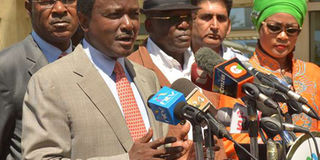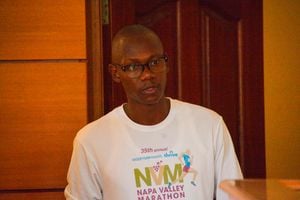Cord should build network of monitors, technology can fail

Cord co-leader Kalonzo Musyoka addresses a press conference at Capital Hill on January 6, 2017. Cord’s desire is to enforce the use of election technology. PHOTO | DENNIS KAVISU
What you need to know:
- Cord leaders pushed for digital technology to be identified as the only legal means of conducting an election.
- Indeed, the Electoral Integrity Project estimates that voter registration is the third most problematic part of the electoral process worldwide.
- Voting could be extended so that areas with particular difficulties would be able to vote the next day.
In the final days of 2016, opposition leaders first called for mass protests against changes to the electoral laws.
These demonstrations were subsequently called off in order to allow the Senate to debate the proposed amendments, but following the Upper Chamber’s decision to adopt the amendments on Friday it seems likely the Coalition for Reform and Democracy (Cord) will press ahead with its plans for street protests.
One of the key issues at stake in the latest election controversy is the status of election technology.
During previous rounds of negotiations, Cord leaders pushed for digital technology to be identified as the only legal means of conducting an election.
This would have prevented the Electoral Commission from being able to revert back to a manual system should the technology fail.
However, the amendments passed by the Jubilee government on December 22 and recently approved by the Senate would have the effect of reinstating the right to use a manual system.
Opposition accusations that this change is designed to facilitate rigging led to scuffles on the floor of the National Assembly, after which Cord legislators walked out of the session.
WORTH IT?
In the wake of deeply problematic polls in 2007 and 2013 it is clear why the opposition is concerned about the prospects for manipulation later this year.
But it is also important to be realistic about what such technology can, and cannot, achieve.
To date, voter registration software has been fairly successful.
In Nigeria, for example, the introduction of digital voter registration for the 2011 election, including the use of an Advance Fingerprint Identification System (AFIS), went some way towards dealing with the problem of multiple voter registration.
In turn, improvements in the voters roll helped to build confidence in the electoral process and facilitated the victory of the opposition in 2015.
The relatively strong record of biometric voter registration is important, because many election registers in Africa are bloated, featuring high numbers of dead voters and in some cases thousands of citizens who are too young to vote.
Indeed, the Electoral Integrity Project estimates that voter registration is the third most problematic part of the electoral process worldwide.
Given this, any technology that can generate a more credible voters roll should be encouraged.
However, other forms of election technology have not worked as well.
Most notably, the biometric kits used to identify voters at polling stations have often failed.
For example, although biometric registration worked relatively well in Nigeria, the biometric verification process could not be used in many areas in 2015 and so officials were forced to fall back on manual voting.
Partly because the technology is notoriously prone to breakdown, few countries have legislated against the use of manual systems.
Indeed, the use of digital verification was not a legal requirement in any of the three countries – Gambia, Ghana, and Nigeria – in which presidents have recently been defeated at the ballot box.
This raises two important questions: is election technology necessary for an opposition to defeat a ruling party, and what other strategies have opposition parties in Africa used to try and create a level playing field?
THE DANGERS OF GOING DIGITAL
It is clear the adoption of election technology does not necessarily prevent election controversy.
The failure of biometric voter registration kits, for example, has often generated a new set of problems.
This danger is well known to Kenyans, because the failure of more than half of the biometric verification kits used during the 2013 General Election was one of the factors that undermined the credibility of the process, leading the opposition to contest the outcome in court.
The reason biometric voter verification fails so often is that any one of a number of problems — equipment malfunction, loss of electricity, batteries running out, poorly trained staff — can cause a hitch.
On polling day, with long lines of people queuing up to vote in the baking sun, the intense time pressure on election officials means halting the voting process to fix the equipment is not always feasible.
Indeed, while Cord’s desire to enforce the use of election technology is understandable, prohibiting the use of manual processes would generate costs as well as benefits.
Most obviously, what happens if many of the kits fail, as they did in 2013?
Would voters in these areas be unable to cast their ballots?
If so, what happens if more kits fail in some parts of the country than others, unfairly disadvantaging certain parties or coalition?
Of course, there are ways around this problem.
Voting could be extended so that areas with particular difficulties would be able to vote the next day, for example.
But this raises further difficult questions: Can ballot boxes be kept securely overnight?
Would turnout be lower if people were asked to come back again a second time?
And what would happen to people who had registered to vote but whose details were not recognised by the electronic system even when it was working?
It is also important to ask how safe electoral technology would be even if it does not malfunction.
MANIPULATION
In 2013, the electronic vote transmission system did not just fail — it also contained a bug that multiplied the number of rejected votes by eight.
No one has yet offered a sufficient explanation for this and in the absence of one it would be unwise to place too much faith in the power of technology.
Digital systems, just like manual ones, can be manipulated.
Given this, it may be worth Cord leaders adopting a multipronged approach to the 2017 polls, pushing for a stronger and more independent electoral commission while improving its own capacity to monitor the polls.
After all, two things are required to make multiple voting, ballot box stuffing, and counting fraud possible: first, a faulty electoral process; second, the absence of party agents or the presence of party agents willing to take bribes to sign off on fraudulent results. While the first is often beyond the control of opposition parties, the second is not.
As in Kenya, the Ghanaian opposition did not trust the ruling party or the Electoral Commission to deliver a fair poll in the run up to the recent election.
Indeed, according to some supporters of the New Patriotic Party (NPP) the new Chairperson of the Commission, Ms Charlotte Osei only got the job because she was a supporter of the ruling National Democratic Congress (NDC).
But despite having very similar fears to Cord, NPP leaders adopted a very different strategy.
Their success should make Odinga, Musyoka and their allies think again about how they can best plan for the upcoming election campaign.
Instead of holding out for a fully digital process, NPP leaders agreed that voters whose fingerprints could not be read by the verification kits should be allowed to register manually.
And while the opposition did spend time pressuring the Electoral Commission over a range of concerns, it devoted most of the scarce resources it had left after eight long years out of power to enhancing the party’s capacity to monitor the elections itself.
There were two main components of this effort.
First, the NPP developed an app through which party agents could upload polling station results, and a photograph of the signed “pink sheets” that verify the figures, to their mobile phones.
Once this had been done, agents could use the app to communicate the information to party leaders.
Second, the NPP identified tens of thousands of party agents, trained them in how to use the technology, and dispatched them to cover the country’s almost 30,000 polling stations.
Six months ahead of the election, the opposition also identified two party activists per constituency.
These activists were given a laptop so that they run a collation centre, receiving communications from party agents and sending them on to the national level.
VERIFIABLE RESULTS
The NPP’s system did not work in all cases. Some agents struggled to access the relevant forms, while others could not get the app to work.
However, many of these obstacles were ultimately overcome, with agents substituting WhatsApp for the party’s own technology and sending messages to the personal accounts of those in the constituency collation centres when required.
Indeed, the effectiveness of this low cost work-around demonstrates that election technology need not cost a fortune.
The fact that the opposition was able to collate a comprehensive set of results – in contrast to the parallel vote tabulations (PVTs) sometimes conducted by election observers, which are typically based on a small random sample — boosted the credibility and accuracy of their findings.
Indeed, the NPP’s early projection of the results, based on the data gathered by its own party agents, was almost perfect.
Party leaders estimated that their candidate, Nana Akufo Addo, had won 53.51 per cent of the vote – just 0.34 per cent less than the 53.85 per cent that was ultimately announced by the Electoral Commission.
The existence of a set of results that gave the opposition a clear lead — and were mostly backed up by copies of the pink sheets used to verify the results — was important because it made it extremely difficult for the Electoral Commission to do anything other than announce the NDC’s defeat.
The EC may have been planning to do this anyway, but the NPP’s impressive election organisation made sure of it.
The beauty of the strategy adopted by the opposition ahead of the 2016 Ghanaian elections is that it did not rely on the government or the electoral commission to work.
As a result, it was less vulnerable to external manipulation and hence failure.
If Cord does not trust the powers that be, and wants to make it harder to manipulate the polls, building a stronger party network is likely to be a more effective tactic than campaigning about election technology.
Cheeseman is Professor of Democracy at Birmingham University





